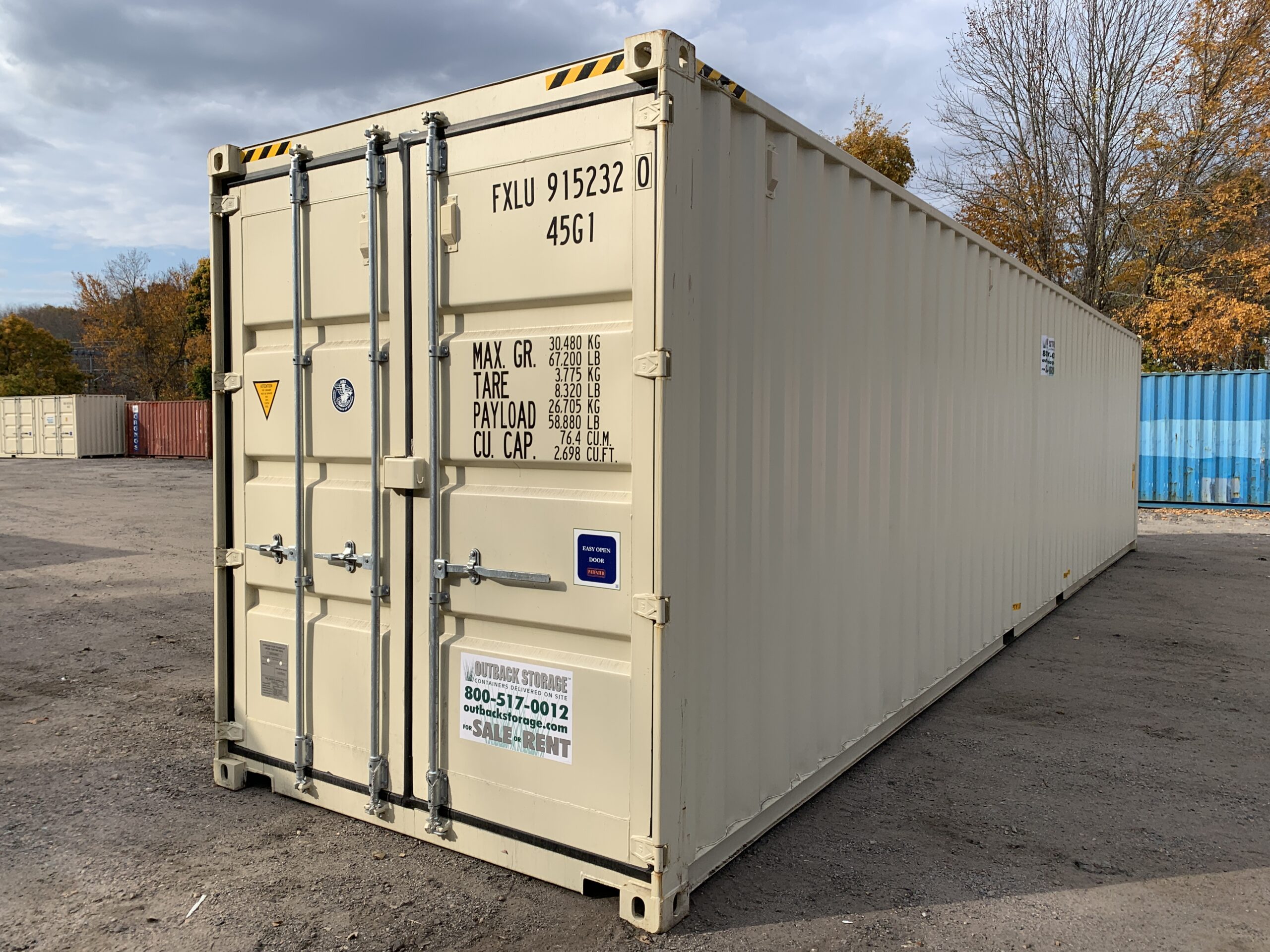I get a lot of requests for quotes from customers across the US outside of my service area of the New England states comprised of Rhode Island, Connecticut, Massachusetts, Maine, New Hampshire, and Vermont. I’ve written the following Buyer’s Guide To Purchasing A Storage Container for customers both from within and outside of my service area. I’ve taken my experience purchasing hundreds of containers over the last six years and tried to simplify and condense it into the following guide. So whether you’re shopping for a container in my service area or somewhere across the US, hopefully you’ll find this guide helpful.
Buyer’s Guide To Purchasing A Storage Container: The main use of steel shipping containers is to transport products across the oceans on cargo ships. Along the way these rugged steel boxes are dented, scratched, scraped, and exposed to the harshest weather yet still protect the goods inside. That is why it has become common for businesses and residents from around the U.S. to buy shipping containers for use as ground level storage at their home or place of business.
Buying Sight Unseen?…Buyer Beware! – There are a lot of companies across the US selling containers to customers “sight unseen”. They’ll arrange the long distance trucking to your location. Their prices may be good. They’ll tell you that the container is in great shape but….once it arrives…it might fall short of your expectations. If at all possible, I strongly recommend going to see the container in person. If that is not possible, I recommend not buying a container from someone you have not done business with before unless they send you a minimum of 5 or 6 good quality pictures of the exact container(s) you will be purchasing. Quite often they will send you one or two pictures of a container that is representative of the container you will be purchasing and not the actual container. Make sure to get a picture of all four sides (with the doors closed) and a couple of the interior, including the floor.
Price vs Supply – The majority of all shipping containers are made in China. The US has a trade imbalance with China. We import from China much more than we export to other parts of the world. In a “normal” world economy, there is a surplus of containers here in the US which leads to a steady supply of containers for those who wish to purchase them. I’ve known this to be the case since I started selling containers in 2004. In 2009, however, we had a worldwide recession. Container manufacturers in China literally closed the factories and stopped manufacturing containers due to there being no demand for them. This was a great year for those wishing to purchase a container as there was a surplus of containers in ports around the country. That all changed in the spring of 2010 when there was a surge in the worldwide demand for storage containers. Due to the factories being closed for most of 2009 coupled with lower container prices for much of 2009….this resulted in a massive container shortage. 2010 has been a challenge for companies such as Out-Back Storage who are in the business of selling containers which continues to this day. Luckily our network of suppliers is diverse and we’ve been able to obtain a steady stream of containers at competitive prices.
Price vs Condition – The price of a container is generally based on its age and condition. Keep in mind that price has more to do with condition when it comes to pricing as it is somewhat commonplace to find, for example, a 10 year old container that is in better condition than a 6 year old container. The reasons for this are many but my best guess would have to be:
- Miles Traveled – By chance, some containers log more miles moving cargo while some spend more time in ports.
- Container Handling – Some containers are handled more roughly by crane and forklift operators. A container that is dented on the outside by careless crane operators will rust wherever paint is chipped. Forklift operators who load and unload the cargo from the interior of the container will sometimes dent the interior of the container with the forks of the forklift causing rust on the interior.
- Container Cargo – Did the cargo spill inside of the container soiling the floor?
- Environment – A cargo container that spent most of it’s time traveling on ships in mild climates will generally show less wear than a container that spent years travelling harsh climates. Imagine the beating a container would take on the North Sea during a winter storm?
- Road Transportation – Was the container damaged while being transported via tractor trailer? The container in the picture to the left actually fell off of a truck while going down the highway. It was bought by me at a greatly reduced rate and resold to a customer who was looking for a bargain.
How Old Is This Container? – Generally there are a couple of quick ways to tell how old a container are:
- Doors – Are the doors of the container flat or corrugated? Generally speaking, a container that has flat doors is an older container. Container manufacturers switched from flat doors to corrugated doors sometime around the early 1990’s.
- CSC Plate – This is the plate affixed to the left hand door of the container which has all of the container information listed on it. It’s akin to a VIN (Vehicle Information Number) on an automobile. On this plate will be listed the date of manufacture of the container.
What To Look Out For –
- Doors- Do they open and close easily? If you’re going into your container every day and you dread having to open and close the doors…you’ve bought the wrong container. However, if you rarely open your container and you get a deal on a container that doesn’t open and close easily, then the purchase may make sense for you. Two things to consider with doors are:
- Locking mechanisms – These are handles that you grab to unlock the container and the vertical rods that actually lock the container at the top and bottom of the container. If the rods or handles are bent, that could make the container hard to open and close. I’ve often seen containers that are relatively easy to open but difficult to close. Make sure to open and close the container yourself as opposed to the person selling you the container as they are generally pro’s at opening and closing difficult containers…! Also, be sure to open both doors. Not just the door on the right.
- Hinges – Once the doors are unlocked, can you easily swing the doors open? Once again…make sure to open both doors all the way.
- Roof – Inspect the roof of the container from the inside. Are there many dents and dings from the top down? If so, that’s where water will collect eventually causing rust to eat through the container. If you can, hop up onto the roof of the container and give it a look also. As on the inside, inspect for dents, dings, and scratches in the paint which will rust through the container roof. I’m not saying you shouldn’t buy a container with dents, dings, and scratches or rust on the roof…I’m merely stating that eventually a hole will develop and that you should plan on addressing it eventually. It might be in a year or it might be in 5 years.
- Door Gaskets – Do the gaskets seal up tight? Keep in mind that containers are double gasketed and that often there will be a chunk taken out of the exterior gasket but the inner gasket will still be intact creating a watertight seal. One place to watch out for rust on the container is where the gasket is affixed to the door. Often rust will develop between the gasket and the door, especially at the bottom of the door.
- Lower Side Wall – Pay attention to the exterior side wall of the container where it meets the flat portion of the steal beam at the bottom of the container. Water will often collect at that point causing rust to eat through the side of the container. I’ve generally only seen this happen on older containers.
Delivery Options vs Cost – If you’re far away from whomever is selling you the container you’re purchasing…typically it’s cheaper to have the container delivered via “flatbed truck” as opposed to “tilt bed truck or trailer”. The reason is that there are many more flat bed vehicles on the road. Tilt beds trucks and trailers are more specialized. Whether you can have your container delivered via flat bed to save some money depends upon whether you have the ability to offload the container at your site or not. To offload at your site you’ll need a good sized forklift or a crane. 20′ containers weigh roughly 4,850 lbs and 40′ containers weigh roughly 8,223 lbs. If you don’t have the ability to offload the container from the truck or trailer, delivery via tilt bed truck or trailer will allow you to have the container placed where you want it.
Shipping Container Grades – Buying a shipping container, otherwise known as a sea crate or conex box can be intimidating if you are unfamiliar with the industry. Shipping containers come in several different “grades” or conditions. And although most distributors understand how to grade a storage container fairly it is good idea to understand what each grade should represent.
Generally speaking, there are six grades of shipping containers commonly referred to. Different vendors may not carry all of these grades or they may have different names for the following grades:
- One-Trip or New Container
- Wind & Water Tight “Grade A” Container
- Wind & Watertight “Grade B” Container
- Refurbished Container
- “As Is” Container (aka “General Purpose” Container)
- Cargo Worthy Container
Below I’ve listed things to consider for each of these types of containers:
One-Trip Storage Containers
Things to consider when purchasing a new “one trip” container are:
Does the container have “high” or “low” locking gear? What I’m referring to are the handles used to open the container. They will typically be at one of two heights. I’ve found that containers built specifically to be used for one trip (from Asia to the US) and then resold once unloaded will have “high” locking gear. Conversely, shipping containers built specifically for shipping lines to be used for 10 or more years both on ships and tractor trailers, will have “low” locking gear. I can only surmise that the reason for this is that a container with “high” locking gear is more difficult to open when it is on the chassis of a trailer as the handles are high up off the ground. If you’re buying a container to use for ground level storage, high locking gear is preferable as you don’t have to bend over as far to grab the handles to open the container.
Does the container have a “Lock Box”? I find that at least 50% of all of the new containers I purchase for resale have “lock boxes”. Simply put, this is a box that is welded onto the edge of the right door of the container which, when the door is closed, covers a hasp which is welded to the left hand door. This allows you to lock the hasp within the box with a padlock that is now unaccessible to the jaws of a bolt cutter, hack saw, or cutoff wheel. Generally speaking, It’s been my experience that lock boxes add roughly $50 to the price of the container when purchased already installed from the factory.
Floor Coating – Typically new containers come through from the factory with bare wooden floors typical to all containers. Occasionally, however, they come through with what I believe is a polyurethane coating on the floor. This gives the floor a nice honey color and makes spills easier to clean up. On rare occasions, I’ve purchase containers with a plastic laminate with a non skid surface. I feel that this is best type of floor to purchase, however, in six years of buying and selling containers…I’ve only seen four containers with this coating on the floor. They were all purchased in 2010 which leads me to believe that perhaps this may become a new trend in container flooring.
Refurbished Storage Containers
What to consider when purchasing a refurbished storage container:
- The Ugly Duckling – You can take a container that is absolutely horrible looking and make it look great with a cheap spray gun and a couple of gallons of paint. You can spray over rusty welds. You can hide flaking rust, blemishes, and rust that is about to break through to the interior of the container. I’ve seen it done and it’s not pretty. To the guy on the street who’s never bought a container before and doesn’t know any better, a container refurbished in this manner looks like a better deal than one that has not been refurbished that is sitting right next to it that may be actually be in much better condition. A quick and dirty paint job does wonders for the looks of a run down container. A container “reburbished” in this manner is not really refurbished. It’s only a matter of time before the rust comes through and the holes appear. Let the buyer beware….
- Was The Container Prepped Properly? – The most time consuming part of refurbishing a shipping container is the prep work. All of the loose and flaky rust needs to be removed with a wire brush on a drill or a grinding wheel on an angle grinder.
- Was The Container Spot Primed? – Companies will claim to prep a container and then shoot it with a paint that has a “zinc primer built in”. That’s not a bad thing in and of itself, however, I feel it is better to take it one step further. I recommend spot priming any rust spots with a “rust converter” which turns any surface rust into a hard substance which is ready to be painted. It’s similar to POR 15 which is used in the restoration of automobiles that have rust.
- Paint – Make sure the container is painted with a high quality exterior paint. Whether it’s brushed, rolled, or sprayed on doesn’t matter as long as the entire container gets covered. Spots that get missed are typically under the flat spot where the side wall meets the beam down at the bottom of the container. Keep in mind that containers that are “sprayed” will typically have a more uniform look than those that are brushed or rolled.
Wind and Water Tight Storage Containers
- Is This Container Really Watertight? – The quickest way to tell if a container has visible holes in it is to go inside the container during daylight hours and have someone (you trust) lock you inside the container. Any holes in the container will be easy to spot. Even tiny holes will be visible. This is only a simple test and not a guarantee that the container is watertight. I’ve seen containers that have passed this test which had surface rust which, once ground off….revealed a hole in the container.
- “A” Grade containers typically have few dents and rust than “B” grade containers.
As-Is Storage Containers
When purchasing an “As Is” shipping container you need to carefully consider your use of the container and your ability to repair it. “As Is” Storage Containers may or may not leak. The doors may be difficult to open and close due to rusty hinges or broken lock mechanisms. They may have dents both large and small. There may be rust or puncture holes in the container. Generally, they are not pretty, however, when available, they are an economical alternative to the buyer who is on a budget. Often they are bought by people who are less concerned with keeping their property dry and more concerned with keeping their stuff from getting stolen.
Cargo Worthy Storage Containers
- New Containers – Typically new containers are valid for 5 years from the date of manufacture located on the CSC Plate which is affixed to the left hand door of the container. It’s my understanding that you do not need a paper certificate so long as the CSC plate shows that the container is within the five year range of having to be “inspected” by a certified marine surveyor.
- Used Containers – Containers that are older than 5 years will need to be re – certified by a marine surveyor. This entails the surveyor physically inspecting the container to ensure that it meets the requirements of certification. If the container “passes”, so to speak, the surveyor will typically issue a paper certificate with the container number, some notes about the condition of the container, and the number of months the container is deemed “cargo worthy” before having to be re – certified. Generally this is for 24 months.




